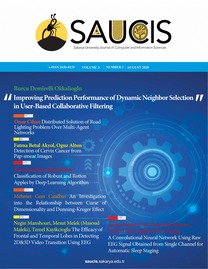A Convolutional Neural Network Using Raw EEG Signal Obtained from Single Channel for Automatic Sleep Staging
Tek Kanallı Ham EEG Sinyali Temelli Otomatik Uyku Evrelemesi Yapan Evrişimsel Sinir Ağı
___
[1] R. Sharma, R.B. Pachori, and A. Upadhyay, “Automatic Sleep Stages Classification Based on Iterative Filtering of Electroencephalogram Signals,” Neural Computing and Applications, vol. 28, no. 10, pp. 2959-2978, 2017.[2] J. A. Hobson, “Sleep: Biochemical Aspects,” New England Journal of Medicine, vol. 281, no. 26, pp. 1468-1470, 1969.
[3] C. Iber, “Development of A New Manual for Characterizing Sleep,” Journal of Sleep and Sleep Disorder Research, vol. 27, no. 2, pp. 190-192, 2004.
[4] B. J. Swihart, B. Caffo and K. Bandeen, “Characterizing Sleep Structure Using the Hypnogram,” Journal of Clinical Sleep Medicine, vol. 4, no.04, pp. 349-355, 2008.
[5] H. Phan, F. Andreotti, N. Cooray and O. Y. Chen, “Joint Classification and Prediction CNN Framework for Automatic Sleep Stage Classification,” IEEE Transactions on Biomedical Engineering, vol. 66, no. 5, pp.1285 – 1296, 2019.
[6] A. Supratak, H. Dong, C. Wu and Y. Guo, “DeepSleepNet: A Model for Automatic Sleep Stage Scoring Based on Raw Single-Channel EEG,” IEEE Transactions on Neural Systems and Rehabilitation Engineering, vol. 25, no. 11, pp. 1998-2008, 2017.
[7] S. J. Redmond and C. Heneghan, “Cardiorespiratory-based Sleep Staging in Subjects with Obstructive Sleep Apnea,” IEEE Transactions on Bio-Medical Engineering, vol. 53, no. 3, pp. 485-496, 2006.
[8] B. Koley and D. Dey, “An Ensemble System for Automatic Sleep Stage Classification Using Single Channel EEG Signal,” Computers in Biology and Medicine, vol. 42, no.12, pp.1186-1195, 2012.
[9] E. Alickovic, J. Kevric and A. Subasi, “Performance Evaluation of Empirical Mode Decomposition, Discrete Wavelet Transform, and Wavelet Packed Decomposition for Automated Epileptic Seizure Detection and Prediction,” Biomedical Signal Processing and Control, vol. 39, pp. 94-102, 2018.
[10] N. Stephansen, E. Shane, C. Jessica, R. Jason. and R. David, “Survey of Machine Learning Techniques in Drug Discovery,” Current Drug Metabolism, vol. 20, no. 3, pp.185-193, 2019.
[11] K. O. Shea and R. Nash, 2015. “An Introduction to Convolutional Neural Networks,” Arxiv:1511.08458v2, 2015.
[12] M. Sokolovsky, F. Guerrero, S. Paisarnsrisomsuk and S. A. Alvarez, “Deep Learning for Automated Feature Discovery and Classification of Sleep Stages,” Transactions of the Institute of Measurement and Control, vol. 38, pp. 435-451, 2018.
[13] H. Ghimatgar, K. Kazemi, M. S. Helfroush. and A. Aarabi, “An Automatic Single-Channel EEG-Based Sleep Stage Scoring Method Based on Hidden Markov Model,” Journal of Neuroscience Methods,” vol. 324, pp. 270-285, 2019.
[14] O. Tsinalis, P. M. Matthews and Y. Guo, “Automatic Sleep Stage Scoring Using TimeFrequency Analysis and Stacked Sparse Autoencoders,” Annals of Biomedical Engineering, vol. 44, pp. 1587-1597, 2016.
[15] J. Zhang, R. Yao, W. Ge and J. Gao, “Orthogonal Convolutional Neural Networks for Automatic Sleep Stage Classification Based on Single-Channel EEG,” Transactions of the Institute of Measurement and Control, vol. 38, pp. 435-451, 2019.
[16] A. Sors, S. Bonnet, S. Mirek, L. Vercueil and J. Payen, “A Convolutional Neural Network for Sleep Stage Scoring from Raw Single-Channel EEG,” Biomed. Signal Proc. Control, vol. 42, pp. 107-114, 2018.
[17] physionet, “MIT-BIH Polysomnographic Database Files,” 1999. [Online]. Available: https://physionet.org/content/slpdb/1.0.0/. [Accessed: 19-Oct-2019].
[18] physionet, “MIT-BIH Polysomnographic Database Information,” 1999. [Online]. Available: https://physionet.org/content/slpdb/1.0.0/slpdb.shtml. [Accessed: 21-Oct-2019].
[19] D. Pedamonti, “Comparison of Non-Linear Activation Functions for Deep Neural Networks on Mnist Classification Task,” Arxiv:1804.02763v1, 2018.
- ISSN: 2636-8129
- Yayın Aralığı: Yılda 3 Sayı
- Başlangıç: 2018
Improving Prediction Performance of Dynamic Neighbor Selection in User-Based Collaborative Filtering
Distributed Solution of Road Lighting Problem Over Multi-Agent Networks
An Investigation into the Relationship between Curse of Dimensionality and Dunning-Kruger Effect
The Efficacy of Frontal and Temporal Lobes in Detecting 2D&3D Video Transition Using EEG
Negin MANSHOURI, Mesut MELEK, Temel KAYIKCIOGLU
Göksu Zekiye ÖZEN, Rayımbek SULTANOV, YUNUS ÖZEN, Zahide YILMAZ GÜNEŞ
Classification of Robust and Rotten Apples by Deep Learning Algorithm
